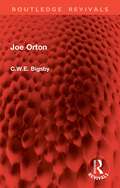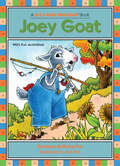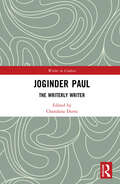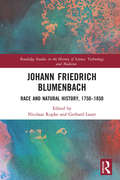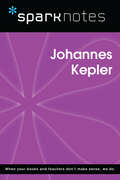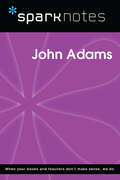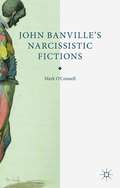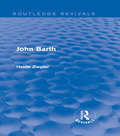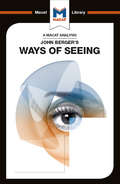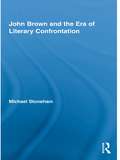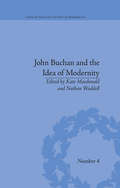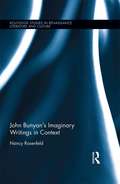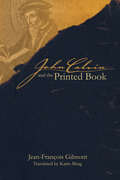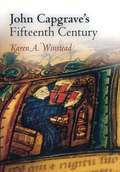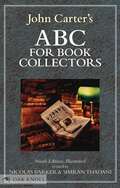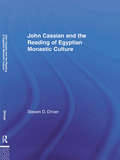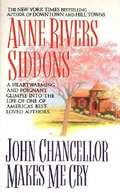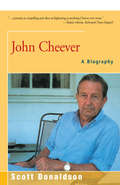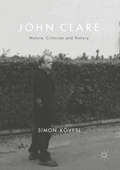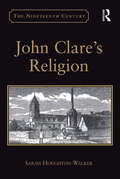- Table View
- List View
Joe Orton (Routledge Revivals)
by C.W.E. BigsbyThough Orton’s roots lay in traditions as diverse as those represented by such writers as Wycherley, Congreve, Wilde, Shaw, Carroll, Firbank, Feydeau, Beckett and Pinter, he developed a form of ‘anarchic farce’ which was very much his own – hence the word ‘Ortonesque’. His work was deliberately subversive, not merely of the authority figures which he included in nearly all his plays, but of language and the congenialities of plot and character. Originally published in 1982, this study examines Orton’s principal plays, but its main concern is to identify his aesthetic, to elaborate the nature and achievements of anarchic farce and to locate him in relation to the developments in contemporary literature and art which have formed essential components of a post-modern sensibility.
Joey Goat: Long Vowel O (Let's Read Together ®)
by Barbara deRubertisLet&’s Read Together books merge rhyme and vowel sounds in delightfully zany stories kids will want to read again and again. Each of the 15 books in this classic series by award-winning author/educator Barbara deRubertis will give your child a jumpstart on reading success."Story lines are silly and inventive, and recall Dr. Seuss&’s Cat in the Hat for the building of rhythm and rhyming words." —School Library JournalJoey Goat likes to play jokes on folks…until he learns how it feels to have a joke played on him! (This easy-to-read story features the long &“o&” vowel sound.)
Joginder Paul: The Writerly Writer (Writer in Context)
by Chandana DuttaThis book is a comprehensive volume on the life and works of Joginder Paul, a well-known Urdu fiction writer and thinker. It presents a selection from the writer’s oeuvre – a few of his short stories, extracts from his long fiction, samples of his micro-fiction, personal reminiscences, and some of his incisive critical essays written in Urdu as well as in English that lay out his ideas on the role of the writer and the art of writing. The volume also contextualises his work within the Urdu literary tradition and beyond through some critical essays on him from across time and geography. It situates Paul as a notable fiction writer and an essayist who broke convention in his writing and crafted his own individual style. It shows how he was received in Urdu while also placing him as an important creative voice within a larger pan-Indian literary context. The book also focuses on Paul’s efforts to effect a change in how fiction should be perceived, particularly by his readers who he considered the most important ally-participant in his effort to create stories. This volume will help to evolve a deeper understanding of the thematic subtleties in his fiction, as well as the critical perspectives he offers in his non-fiction. Part of the Writer in Context series, this book will be indispensable to scholars and researchers in literature, history, sociology, language and creative writing, Partition studies, translation studies, Indian writings, Urdu literature, postcolonial studies, and South Asian Studies.
Johann Friedrich Blumenbach: Race and Natural History, 1750–1850 (Routledge Studies in the History of Science, Technology and Medicine)
by Nicolaas Rupke Gerhard LauerThe major significance of the German naturalist-physician Johann Friedrich Blumenbach (1752–1840) as a topic of historical study is the fact that he was one of the first anthropologists to investigate humankind as part of natural history. Moreover, Blumenbach was, and continues to be, a central figure in debates about race and racism. How exactly did Blumenbach define race and races? What were his scientific criteria? And which cultural values did he bring to bear on his scheme? Little historical work has been done on Blumenbach’s fundamental, influential race work. From his own time till today, several different pronouncements have been made by either followers or opponents, some accusing Blumenbach of being the fountainhead of scientific racism. By contrast, across early nineteenth-century Europe, not least in France, Blumenbach was lionized as an anti-racist whose work supported the unity of humankind and the abolition of slavery. This collection of essays considers how, with Blumenbach and those around him, the study of natural history and, by extension, that of science came to dominate the Western discourse of race.
Johann Gutenberg: the Inventor of Printing
by Victor ScholdererThis short book draws on legal documents surviving from the 15th century, in an attempt to piece together information about the life of the inventor of the printing press. When all is said and done, however, very little can actually be known about Gutenberg's life.
Johannes Kepler (SparkNotes Biography Guide)
by SparkNotesJohannes Kepler (SparkNotes Biography Guide) Making the reading experience fun! SparkNotes Biography Guides examine the lives of historical luminaries, from Alexander the Great to Virginia Woolf. Each biography guide includes:An examination of the historical context in which the person lived A summary of the person&’s life and achievements A glossary of important terms, people, and events An in-depth look at the key epochs in the person&’s career Study questions and essay topics A review test Suggestions for further reading Whether you&’re a student of history or just a student cramming for a history exam, SparkNotes Biography guides are a reliable, thorough, and readable resource.
John Adams (SparkNotes Biography Guide)
by SparkNotesJohn Adams (SparkNotes Biography Guide) Making the reading experience fun! SparkNotes Biography Guides examine the lives of historical luminaries, from Alexander the Great to Virginia Woolf. Each biography guide includes:An examination of the historical context in which the person lived A summary of the person&’s life and achievements A glossary of important terms, people, and events An in-depth look at the key epochs in the person&’s career Study questions and essay topics A review test Suggestions for further reading Whether you&’re a student of history or just a student cramming for a history exam, SparkNotes Biography guides are a reliable, thorough, and readable resource.
John Banville’s Narcissistic Fictions: The Spectral Self
by Mark O’ConnellIn reading Banville's novels through the work of key psychoanalytical theorists, John Banville's Narcissistic Fictions brings together apparently disparate thematic strands - missing twins, shame, false identities - and presents these as manifestations of a central concern with narcissism.
John Barth (Routledge Revivals)
by Heide ZieglerJohn Barth represents most completely what has been termed postmodernism, not because his work comprises more postmodernist features than other contemporary writers but because, for Barth, "life" and "art" are two sides of the same coin. In this brief study, first published in 1987, Heide Ziegler examines all Barth’s novels. She argues that each pair of novels first "exhausts" and then "replenishes" those literary genres that hinge on a particular world view: the existentialist novel, the Bildungsroman, the Kunstlerroman, or the realistic novel. Through the division of labour between character and author Barth manages to develop a new mode of literary parody which projects itself beyond the mocked literary model and even self-parody into the realm of future fiction. This book is ideal for students of literature and postmodern studies.
John Berger's Ways of Seeing (The Macat Library)
by Emmanouil KalkanisWays of Seeing is a key art-historical work that continues to provoke widespread debate. It is comprised of seven different essays, three of which are pictorial and the other containing texts and images. Berger first examines the relationship between seeing and knowing, discussing how our assumptions affect how we see a painting. He moves on to consider the role of women in artwork, particularly regarding the female nude. The third essay deals with oil painting looking at the relationship between subjects and ownership. Finally, Berger addresses the idea of ownership in a consumerist society, discussing the power of imagery in advertising, with particular regards to photography.
John Brown and the Era of Literary Confrontation (Studies in American Popular History and Culture)
by Michael StonehamRadical abolitionist and freedom-fighter John Brown inspired literary America to confrontation during his short but dramatic career as a public figure in antebellum America. Emerging from obscurity during the violent struggle to determine how Kansas would enter the Union in 1856, John Brown captured the imagination of the most prominent Eastern literary figures following his dramatic, though failed raid on Harper’s Ferry. Impressed by Brown’s forthright defense of his attempt to initiate the end of slavery, Whittier, Whitman, Melville, Longfellow, and Howells responded to the abolitionist with poetic tributes suggesting that Brown was a liberating hero, while Emerson and Thoreau celebrated his effort to inspire the nation to a new moral awareness of the common humanity of all men. Responses, however, were not uniform, as these and other figures debated the merits and meanings of Brown’s actions. This exceptional book sheds new light on how John Brown inspired America’s most significant intellects to take a public stand against the inertia of moral compromise and social degeneracy, bringing the nation to the brink of civil war.
John Brunner
by Jad SmithUnder his own name and numerous pseudonyms, John Brunner (1934-1995) was one of the most prolific and influential science fiction authors of the late twentieth century. During his exemplary career, the British author wrote with a stamina matched by only a few other great science fiction writers and with a literary quality of even fewer, importing modernist techniques into his novels and stories and probing every major theme of his generation: robotics, racism, drugs, space exploration, technological warfare, and ecology. In this first intensive review of Brunner's life and works, Jad Smith carefully demonstrates how Brunner's much-neglected early fiction laid the foundation for his classic Stand on Zanzibar and other major works such as The Jagged Orbit, The Sheep Look Up, and The Shockwave Rider. Making extensive use of Brunner's letters, columns, speeches, and interviews published in fanzines, Smith approaches Brunner in the context of markets and trends that affected many writers of the time, including Brunner's uneasy association with the "New Wave" of science fiction in the 1960s and '70s. This landmark study shows how Brunner's attempts to cross-fertilize the American pulp tradition with British scientific romance complicated the distinctions between genre and mainstream fiction and between hard and soft science fiction and helped carve out space for emerging modes such as cyberpunk, slipstream, and biopunk.
John Buchan and the Idea of Modernity (Literary Texts and the Popular Marketplace #4)
by Kate Macdonald Nathan WaddellConsidered a quintessentially 'popular' author, John Buchan was a writer of fiction, journalism, philosophy and Scottish history. By examining his engagement with empire, psychoanalysis and propaganda, the contributors to this volume place Buchan at the centre of the debate between popular culture and the modernist elite.
John Bunyan’s Imaginary Writings in Context (Routledge Studies in Renaissance Literature and Culture)
by Nancy RosenfeldWithin the last half-century, early scholarly approaches and analysis of John Bunyan’s Pilgrim’s Progress have seen siginificant advances in mandating and enabling a more contextualized view of Bunyan’s oeuvre. Utilizing this fresh examination of context, John Bunyan’s Imaginary Writings in Context explores Bunyan’s writings in a double context: his fictional works vis-à-vis his own non-fictional writings, and his fictional writings in the context of written materials by other authors – books, tracts, spiritual biographies, and poems available to Bunyan. This volume presents these recent developments by blurring the boundaries between fiction and non-fiction, between literature and history, and in the case of Bunyan, between imaginative literatures in fiction and theological writing. Moreover, this book aims to delineate the imaginary world underlying Bunyan’s fictional writings by viewing Bunyan’s own fictional works in tandem with his non-fiction writings. Simultaneously it situates aspects of Bunyan’s fiction in the context of writings available to him, whether these be Holy Scripture, religious tracts by other authors, or ballads and short texts current in the wider culture of the time.
John Burningham's ABC
by John Burningham"A is for apple; L is for lion." The capital letter is written first and is followed by the small letter. Then, a word which begins with the featured letter. age range: infant-preschool This file should make an excellent embossed braille copy.
John Calvin and the Printed Book (Sixteenth Century Essays & Studies #72)
by Jean-François GilmontJohn Calvin made a significant contribution to the world of early modern printing. Jean-François Gilmont, one of the foremost experts in the field, has thoroughly researched and presented all aspects of John Calvin's interaction with books—from the authors he read, to the works he wrote, to his relationships with the printing and publishing world of the sixteenth century. Originally in French, Karin Maag makes Gilmont's research available in this English translation.
John Capgrave's Fifteenth Century
by Karen A. WinsteadBritain of the fifteenth century was rife with social change, religious dissent, and political upheaval. Amid this ferment lived John Capgrave--Austin friar, doctor of theology, leading figure in East Anglian society, and noted author. Nowhere are the tensions and anxieties of this critical period, spanning the close of the medieval and the dawn of early modern eras, more eloquently conveyed than in Capgrave's works. John Capgrave's Fifteenth Century is the first book to explore the major themes of Capgrave's writings and to relate those themes to fifteenth-century political and cultural debates. Focusing on Capgrave's later works, especially those in English and addressed to lay audiences, it teases out thematic threads that are closely interwoven in Capgrave's Middle English oeuvre: piety, intellectualism, gender, and social responsibility. It refutes the still-prevalent view of Capgrave as a religious and political reactionary and shows, rather, that he used traditional genres to promote his own independent viewpoint on some of the most pressing controversies of his day, including debates over vernacular theology, orthodoxy and dissent, lay (and particularly female) spirituality, and the state of the kingdom under Henry VI.The book situates Capgrave as a figure both in the vibrant literary culture of East Anglia and in European intellectual history. John Capgrave's Fifteenth Century offers a fresh view of orthodoxy and dissent in late medieval England and will interest students of hagiography, religious and cultural history, and Lancastrian politics and society.
John Carter's ABC for Book Collectors
by John Carter Nicolas Barker Simran ThadaniThis ninth edition has been thoroughly revised and re-edited by Nicolas Barker, former Editor of The Book Collector, and Simran Thadani, Executive Director of Letterform Archive. With a new Introduction, it incorporates new terms, additions and amendments and, for the first time, illustrations in black & white and color. Nicolas Barker worked with his friend John Carter revising the ABC up to the latter's death in 1975 and has faithfully preserved the spirit of the original. ABC for Book Collectors, while keeping us up-to-date with modern terminology, retains its humorous character and importance as the one indispensable guide to book collecting.
John Cassian and the Reading of Egyptian Monastic Culture (Studies in Medieval History and Culture #8)
by Steven D. DriverThis book examines the method of meditative reading encouraged by John Cassian (c. 360-435) in his ascetic writings, the bulk of which are fictive dialogues that purportedly record the instruction he had received from Egyptial Christian monks. This instruction was at its core an interactive experience, depending upon both the discernment of the master and diligent application of instruction by the student. Driver examines Cassian's understanding of the act of reading and suggests the implications of this for Cassian's monastic teaching and it interprets Cassian's method of reading in light of contemporary discussions of reading and the self.
John Chancellor Makes Me Cry
by Anne Rivers SiddonsAn insightful look at how Siddons has chosen to live in our world, through a collection of heartfelt and involving vignettes
John Cheever: A Biography
by Scott Donaldson"A biography of great immediacy. . . . There are many sections of great poignancy, many funny things, many of electric intimacy and candor . . . there is spellbinding power, never more so than in describing Cheever's death, pages that are both terrible and deeply moving; one is losing an old, beloved friend." --James Salter, Los Angeles Times Book Review "John Cheever: A Biography is clearly an indispensable book. Donaldson moves gracefully from the personal to the literary. . . . Solidly researched and entirely readable, admiring of the writer and knowing about the man. Stuffed with fascinating anecdotes. It's a gut-wrenching story. Donaldson tells it straight, without embellishment, and our attention never strays." --Dan Cryer, Newsday "A coup of investigative reporting." --Publishers Weekly "Both erudite and earthly. What emerges is a rich tapestry that gives the reader extraordinary insight into the workings of a master storyteller's mind." --Jean Graham, New York Daily News "John Cheever: A Biography by Scott Donaldson is as readable and 'unputdownable' as any thriller." --T. Coraghessan Boyle "A revelation. What a triumph." --Frederick Exley "Donaldson has set a high standard that other biographers will find difficult to equal." --John Blades, Chicago Tribune
John Clare
by Simon KövesiJohn Clare (1793–1864) has long been recognized as one of England's foremost poets of nature, landscape and rural life. Scholars and general readers alike regard his tremendous creative output as a testament to a probing and powerful intellect. Clare was that rare amalgam ‒ a poet who wrote from a working-class, impoverished background, who was steeped in folk and ballad culture, and who yet, against all social expectations and prejudices, read and wrote himself into a grand literary tradition. All the while he maintained a determined sense of his own commitments to the poor, to natural history and to the local. Through the diverse approaches of ten scholars, this collection shows how Clare's many angles of critical vision illuminate current understandings of environmental ethics, aesthetics, Romantic and Victorian literary history, and the nature of work.
John Clare and Community
by John GoodridgeJohn Clare (1793-1864) is one of the most sensitive poetic observers of the natural world. Born into a rural laboring family, he felt connected to two communities: his native village and the Romantic and earlier poets who inspired him. The first part of this study of Clare and community shows how Clare absorbed and responded to his reading of a selection of poets including Chatterton, Bloomfield, Gray and Keats, revealing just how serious the process of self-education was to his development. The second part shows how he combined this reading with the oral folk-culture he was steeped in, to create an unrivaled poetic record of a rural culture during the period of enclosure, and the painful transition to the modern world. In his lifelong engagement with rural and literary life, Clare understood the limitations as well as the strengths in communities, the pleasures as well as the horrors of isolation.
John Clare's Religion (The\nineteenth Century Ser.)
by Sarah Houghton-WalkerAddressing a neglected aspect of John Clare's history, Sarah Houghton-Walker explores Clare's poetry within the framework of his faith and the religious context in which he lived. While Clare expressed affection for the Established Church and other denominations on various occasions, Houghton-Walker brings together a vast array of evidence to show that any exploration of Clare's religious faith must go beyond pulpit and chapel. Phenomena that Clare himself defines as elements of faith include ghosts, witches, and literature, as well as concepts such as selfhood, Eden, eternity, childhood, and evil. Together with more traditional religious expressions, these apparently disparate features of Clare's spirituality are revealed to be of fundamental significance to his poetry, and it becomes evident that Clare's experiences can tell us much about the experience of 'religion', 'faith', and 'belief' in the period more generally. A distinguishing characteristic of Houghton-Walker's approach is her conviction that one must take into account all aspects of Clare's faith or else risk misrepresenting it. Her book thus engages not only with the facts of Clare's religious habits but also with the ways in which he was literally inspired, and with how that inspiration is connected to his intimations of divinity, to his vision of nature, and thus to his poetry. Belief, mediated through the idea of vision, is found to be implicated in Clare's experiences and interpretations of the natural world and is thus shown to be critical to the content of his verse.
